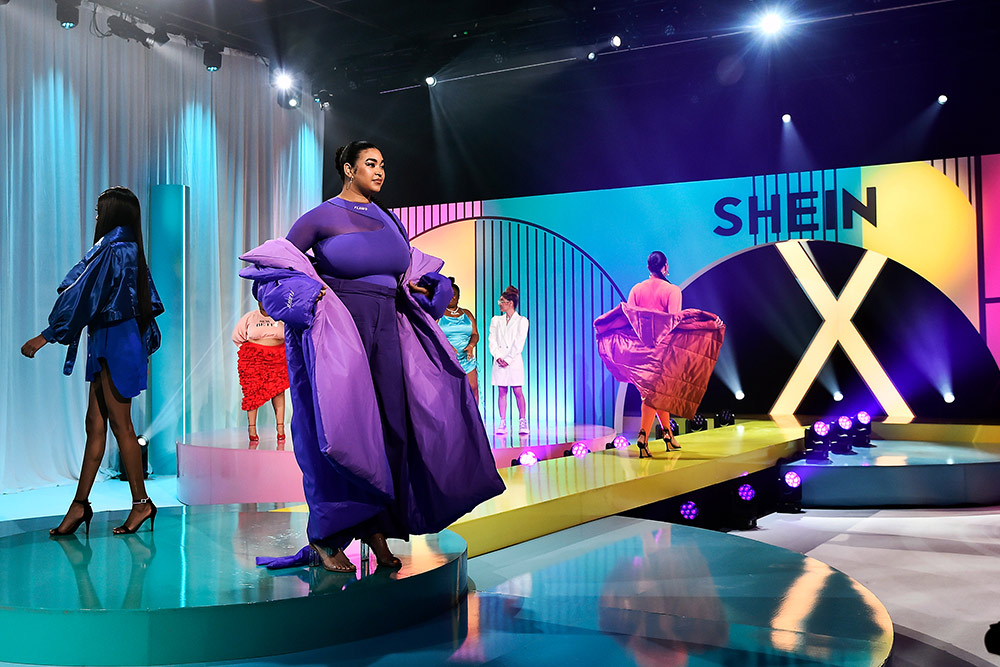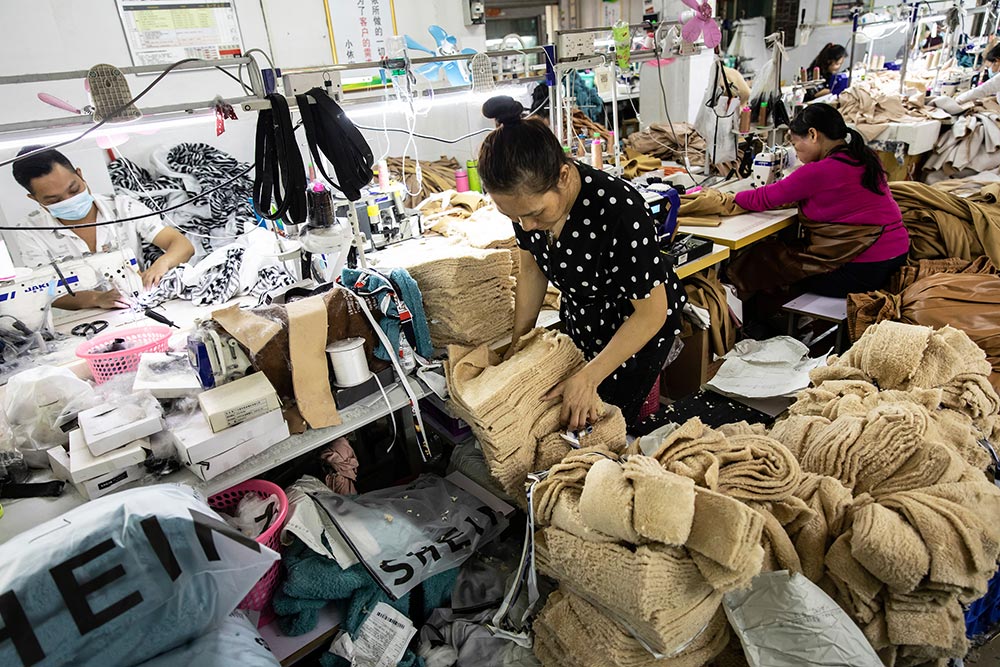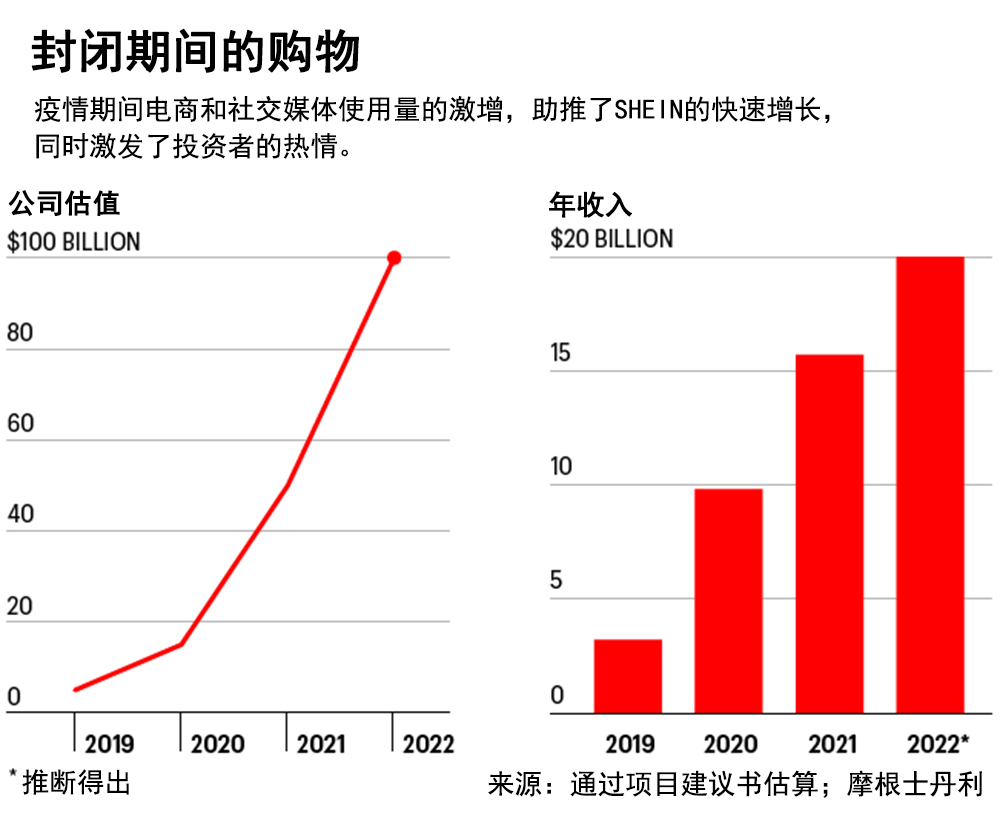
TikTok上有一個(gè)名叫露西尼婭·托馬斯的主播,憑借拍平價(jià)穿搭的短視頻,已經(jīng)吸引了將近10.6萬個(gè)粉絲,。有一陣子,,她的粉絲量漲得特別快,就是因?yàn)樗牧艘幌盗袑Ρ葍蓚€(gè)快時(shí)尚品牌產(chǎn)品的段子——Zara和Shein(中文名希音),。比如有一個(gè)段子的播放量達(dá)到了940萬次,,她在這個(gè)段子里只是展示了兩件基本上一模一樣的墨綠色裙子——一件是Zara的,賣價(jià)79美元,。另一件是希音的,,只賣15美元。
她的很多觀眾在評論區(qū)表示,,他們根本看不出來這兩條裙子有任何區(qū)別,。“這難道不是一樣的,?只不過Zara喪心病狂地賣得更貴,?”另一個(gè)粉絲表示:“我一直在希音上買東西,反正我又不是每天都只穿這一條裙子,?!?/p>
最近幾個(gè)月,諸如“#Zara VS 希音”,、“#山寨Zara”之類的標(biāo)簽已經(jīng)成了各大社交媒體平臺的熱詞,,在TikTok上的播放量已經(jīng)達(dá)到4000萬。在Instagram上也有幾個(gè)賬戶是專門炒這個(gè)話題的,,,比如一個(gè)名叫@zara.vs.shein的賬戶已經(jīng)吸引了47,000多個(gè)粉絲,。
前些年,“快時(shí)尚”概念帶火了Zara和H&M等零售商,。他們的衣服基本上只能穿一季,,下一波流行到來時(shí)就可以扔了——畢竟沒有人會(huì)天天穿同一件衣服出街。而現(xiàn)在,,希音卻“走了Zara的路,,讓Zara無路可走”。希音是一家已成立12年的在線零售商,,總部位于中國南京,。它利用了實(shí)時(shí)數(shù)據(jù)、社交媒體宣傳和龐大的工廠網(wǎng)絡(luò),,生產(chǎn)和大牌快時(shí)尚品牌差不多的設(shè)計(jì),,但它的上市速度更快,售價(jià)更低,。雖然95后和00后的年輕人都說自己關(guān)心環(huán)保事業(yè),,但是希音在美國銷量的蓬勃增長證明了他們的“口嫌體直”,。希音的快速增長和它的忠誠用戶群甚至吸引了不少初創(chuàng)公司開始復(fù)制希音的“比快時(shí)尚更快”的路線。這一現(xiàn)象甚至可能重塑零售業(yè)的格局,。
雖然全球投資者在環(huán)境社會(huì)和治理(ESG)問題上的標(biāo)準(zhǔn)越來越高,,但是他們也喜歡希音。在投資者的追捧下,,希音的估值已經(jīng)達(dá)到1,000億美元,,它目前僅次于字節(jié)跳動(dòng)和馬斯克的SpaceX,是全球估值第三高的初創(chuàng)公司,。據(jù)彭博社報(bào)道,,希音現(xiàn)在的估值已經(jīng)超過了H&M和Zara母公司Inditex的總和。
雖然希音的創(chuàng)新商業(yè)模式可能會(huì)為消費(fèi)者省下不少錢,,但業(yè)界也不乏關(guān)于它的負(fù)面輿論,。有人說,希音的商業(yè)版圖是建立在廉價(jià)勞動(dòng)力和山寨產(chǎn)品上的,,而且希音使用了人工智能設(shè)計(jì)軟件,它大大加快了消費(fèi)者拋棄舊衣服的速度,,從而會(huì)對地球環(huán)境不利。這些負(fù)面輿論,,加上最近全球電商市場總體放緩,使得該公司未來能否繼續(xù)霸占“快時(shí)尚”市場還是一個(gè)未知數(shù),。
****
希音創(chuàng)始人,、CEO許仰天是個(gè)在國內(nèi)極其低調(diào)的人物,他曾是一名搜索引擎優(yōu)化專家,,也是一名科技創(chuàng)業(yè)人,。之前他曾經(jīng)在網(wǎng)上賣過婚紗禮服。大概十幾年前,,許仰天創(chuàng)辦了希音,。雖然當(dāng)時(shí)快時(shí)尚市場的競爭已然十分激烈,但是許仰天認(rèn)為,,他可以通過降低價(jià)格來實(shí)現(xiàn)差異化,,他的優(yōu)勢是背靠國內(nèi)龐大的供應(yīng)商網(wǎng)絡(luò),因此可以在更短的時(shí)間內(nèi)將服裝從概念變成實(shí)物,。
起初,,希音是面向中國消費(fèi)者的,但是彼時(shí)的中國市場已經(jīng)被各個(gè)超低價(jià)的電商平臺擠破了頭,。所以從2015年開始,,希音開始把目光投向海外。該公司迅速擴(kuò)大了在美國的業(yè)務(wù)版圖,,而美國現(xiàn)在已經(jīng)成了希音的最大市場,。
零售業(yè)咨詢機(jī)構(gòu)Coresight Research公司的高級分析師艾琳·施密特指出,希音采取了“小步快跑”,、“測試-重復(fù)”的策略,。希音的一個(gè)單品一次可能只生產(chǎn)100件,而Zara的每個(gè)新設(shè)計(jì)都是試產(chǎn)500件起步,。由于它限制了新訂單的規(guī)模,,所以希音無需進(jìn)行大量前期投資,就可迅速探知消費(fèi)者的喜好,。如果實(shí)時(shí)數(shù)據(jù)顯示消費(fèi)者很喜歡這件單品,那么希音就會(huì)迅速追加訂單。希音會(huì)用這種方法每天測試新品數(shù)百次。它的網(wǎng)站每24小時(shí)就會(huì)增加6,000個(gè)新品。因此,用戶已經(jīng)習(xí)慣了定期訪問希音的平臺,,否則就有可能錯(cuò)過最新款的設(shè)計(jì)。

此外,,希音還最大程度縮短了設(shè)計(jì)時(shí)間,,從而獲得了速度優(yōu)勢,。據(jù)零售業(yè)分析機(jī)構(gòu)1010data 公司的首文技術(shù)官特里·薩奇介紹,,Zara和H&M一般追的是國際大型秀場的流行趨勢,往往需要幾周時(shí)間才能設(shè)計(jì)出類似風(fēng)格的服裝,。而希音則開發(fā)了一種內(nèi)部設(shè)計(jì)軟件,,它的視覺引擎使用了深度學(xué)習(xí)技術(shù),,可以執(zhí)行物體識別等功能,這是讓希音的反應(yīng)速度能夠超越國際競爭對手的一個(gè)“秘密武器”,。希音采用了最先進(jìn)的神經(jīng)網(wǎng)絡(luò)技術(shù),,“可以在十分之一秒內(nèi)識別一個(gè)物品?!彼募夹g(shù)遠(yuǎn)比其他競爭對手更快,、更高效。該軟件可以在TikTok等社交媒體平臺實(shí)時(shí)搜索最新的流行趨勢,,它還能識別出圖片和視頻中的物品,,并將其與希音的產(chǎn)品庫配對。然后希音會(huì)將這些數(shù)據(jù)與一些簡單的數(shù)據(jù)與它的龐大供應(yīng)商網(wǎng)絡(luò)進(jìn)行匹配,。希音在中國有6,000多家供應(yīng)商,不到10天就可以生產(chǎn)和配送一件單品,。而英國快時(shí)尚品牌Boohoo要想完成這一過程則需要4至6周,。
網(wǎng)上有些視頻指出,,希音的有些產(chǎn)品剽竊了競爭對手的創(chuàng)意。還有些批評人士指責(zé)希音賣山寨產(chǎn)品,。希音公司在一份給《財(cái)富》的聲明中表示:該公司“尊重設(shè)計(jì)師,、藝術(shù)家和其他人的知識產(chǎn)權(quán),并要求供應(yīng)商遵守相關(guān)規(guī)定……一旦發(fā)現(xiàn)不合規(guī)的行為,公司就會(huì)立即采取行動(dòng),?!?/p>
Zara并未回應(yīng)《財(cái)富》的置評請求。不過,,零售咨詢公司Spieckerman Retail的總裁卡羅爾·斯派克曼指出,,由于時(shí)尚周期的變化實(shí)在太快,Zara等競爭對手基本上沒有采取法律行動(dòng)的動(dòng)機(jī),。有些獨(dú)立設(shè)計(jì)師和藝術(shù)家也指責(zé)希音剽竊他們的作品,,但他們卻缺乏維權(quán)的法律資源。美國版權(quán)法對時(shí)尚設(shè)計(jì)提供的保護(hù)很少,。福雷斯特咨詢公司首席研究分析師蘇查里塔·柯達(dá)利表示:“不管是公司還是個(gè)人,,他們能做的事情都不多,尤其面對希音這樣的境外企業(yè),?!北热缦R粲幸豢頛V的同款錢包,只賣3.12美元,,但它幾乎沒有面臨任何法律上的后果,。
****
疫情是希音的一個(gè)重大轉(zhuǎn)折點(diǎn)。由于希音沒有線下實(shí)體店,,加之它在中國有龐大的工廠網(wǎng)絡(luò),,因此希音相比那些倉促上馬網(wǎng)店的快時(shí)尚品牌具有一定的先發(fā)優(yōu)勢。根據(jù)數(shù)據(jù)供應(yīng)商Apptopia的數(shù)據(jù),,希音APP的下載量已經(jīng)從2019年的6,700萬次飆升至去年的1.93億次,,是全球下載量第二大的網(wǎng)購類APP。
希音在社交媒體上的影響力也是不容小覷的,,而這一點(diǎn)在疫情爆發(fā)后的“居家時(shí)代”顯得特別重要,。希音在美國有不少“網(wǎng)紅”為其代言,其中既有自媒體網(wǎng)紅,,也有像科勒·卡戴珊這樣的頂流,。這些網(wǎng)紅會(huì)在他們的賬號上推廣希音的產(chǎn)品,以換取一定的費(fèi)用或者免費(fèi)產(chǎn)品,。疫情期間,,希音還舉辦了多場線上和線下的演唱會(huì)。比如它2020年5月的一場音樂會(huì)就請來了Doja Cat和Lil Nas X等深受美國95后和00后追捧的音樂人,。希音的官方賬戶目前在TikTok上擁有410萬粉絲,。而Zara只有130萬粉絲,美國零售品牌ASOS只有120萬粉絲,,H&M的粉絲更是只有155,000人,。
希音的物流采取的是從中國直接郵寄給消費(fèi)者的模式,,這種模式也讓它在中美貿(mào)易戰(zhàn)中獲得了一定的好處。2018年,,作為對美國加征中國進(jìn)口商品關(guān)稅的回應(yīng),,中方取消了向美國消費(fèi)者直接發(fā)貨的企業(yè)的出口稅。而且希音還利用了美國對價(jià)值800美元以下郵包的關(guān)稅豁免政策,。
據(jù)彭博社近日報(bào)道,,2020年,希音的收入達(dá)到100億美元,,較上年增長250%。但是去年,,隨著疫情的嚴(yán)峻形勢有所好轉(zhuǎn),,人們外出的頻率增加,希音的收入增長率也回落至60%,,營收達(dá)到160億美元,。據(jù)投資銀行摩根士丹利預(yù)計(jì),希音今年的收入將達(dá)到200億美元,。
希音業(yè)務(wù)的蓬勃發(fā)展也招來了一些環(huán)保人士和勞工權(quán)益人士的非議,。Good on You是美國的一家非盈利機(jī)構(gòu),它會(huì)根據(jù)一些ESG標(biāo)準(zhǔn)對快時(shí)尚品牌進(jìn)行評級,。該機(jī)構(gòu)表示,,希音在環(huán)保和勞工權(quán)益問題上的得分“非常低”,并稱希音“很少采用環(huán)保材料……而且沒有證據(jù)表明,,它采取了有意義的行動(dòng)來減少或消除供應(yīng)鏈中的危險(xiǎn)化學(xué)品和碳排放”,。
希音在可持續(xù)發(fā)展和社會(huì)影響報(bào)告中闡述了它的ESG目標(biāo),但并沒有給出具體行動(dòng)和時(shí)間表,。比如希音表示,,它將在產(chǎn)品和包裝中“使用更多可回收材料”。
在勞工方面,,批評人士指責(zé)希音片面追求效訓(xùn)練法,,而給供應(yīng)商帶來了很大壓力。根據(jù)瑞士勞工權(quán)益組織“公共之眼”(Public Eye)2021年的一份報(bào)告稱,,這導(dǎo)致了希音的供應(yīng)商工廠出現(xiàn)了“過度加班”和生產(chǎn)條件不安全等現(xiàn)象,。
從6月21日開始,希音還將面臨一個(gè)供應(yīng)鏈方面的新難題——美國將以涉嫌強(qiáng)迫勞動(dòng)為借口,,禁止進(jìn)口含有新疆棉的商品,。這個(gè)禁令是十分沉重的,既便是一些擁有成熟和多元化供應(yīng)鏈的零售商也難以遵守,。而希音的供應(yīng)鏈幾乎全部都在中國,,所以它肯定會(huì)從新疆采購棉花,因?yàn)橹袊?5%的棉花都產(chǎn)自新疆。
關(guān)于這些問題,,希音表示,,它“采取了嚴(yán)格的供應(yīng)商行為準(zhǔn)則,包括嚴(yán)格的健康和安全政策……以及禁止供應(yīng)鏈出現(xiàn)強(qiáng)迫勞動(dòng)現(xiàn)象的政策,。我們將與世界各地的第三方組織合作,,對我們的原材料進(jìn)行追蹤?!?/p>
雖然希音在勞工和環(huán)保問題上遭到了一些非議,,但這并不能阻擋投資者的熱情。據(jù)多家媒體報(bào)道,,今年4月,,希音拿到了一輪10至20億美元的融資,其估值也上升至1000億美元,。領(lǐng)投機(jī)構(gòu)包括私募股權(quán)公司General Atlantic,、風(fēng)投巨頭紅杉資本中國和老虎全球管理基金等。
紅杉中國合伙人鄒家佳認(rèn)為,,希音的商業(yè)模式是“革命性的”,,并表示希音基于人工智能的供應(yīng)鏈能夠更加準(zhǔn)確地預(yù)測銷量和產(chǎn)量,從而可以“減少過度生產(chǎn),,解決低效和浪費(fèi)問題”,。

斯派克曼也表示,她理解希音為何對投資者如此具有吸引力——這是一家高交易量而且只做電商的公司,,它在95后的年輕人中極有市場,,這表明它的業(yè)務(wù)可以長期健康發(fā)展。她還表示,,希音的人工智能生產(chǎn)模式也是一個(gè)“強(qiáng)大的競爭優(yōu)勢”,。
不過斯克派提醒道,由于希音是一家私營公司,,不會(huì)對外披露財(cái)務(wù)數(shù)據(jù),,因此外部人對它的真實(shí)價(jià)值只能靠猜測?!拔覀儾⒉恢老R羰欠裾鎸?shí)盈利,,也不知道它的利潤是否具有可持續(xù)性?!?/p>
不過,,這些疑問似乎并不影響消費(fèi)者和投資者的熱情。據(jù)路透社報(bào)道,,希音正在計(jì)劃申請IPO,,不過希音的一個(gè)發(fā)言人表示,,該公司短期內(nèi)并沒有馬上上市的計(jì)劃。
由于希音取的巨大成功,,一些公司已經(jīng)開始“山寨”它的商業(yè)模式了,。未來的快時(shí)尚品牌,很有可能比現(xiàn)在更快,、更時(shí)尚,,“穿一次就扔”或許將變得更加普遍。(財(cái)富中文網(wǎng))
譯者:樸成奎
TikTok上有一個(gè)名叫露西尼婭·托馬斯的主播,,憑借拍平價(jià)穿搭的短視頻,,已經(jīng)吸引了將近10.6萬個(gè)粉絲。有一陣子,,她的粉絲量漲得特別快,,就是因?yàn)樗牧艘幌盗袑Ρ葍蓚€(gè)快時(shí)尚品牌產(chǎn)品的段子——Zara和Shein(中文名希音)。比如有一個(gè)段子的播放量達(dá)到了940萬次,,她在這個(gè)段子里只是展示了兩件基本上一模一樣的墨綠色裙子——一件是Zara的,賣價(jià)79美元,。另一件是希音的,,只賣15美元。
她的很多觀眾在評論區(qū)表示,,他們根本看不出來這兩條裙子有任何區(qū)別,。“這難道不是一樣的,?只不過Zara喪心病狂地賣得更貴,?”另一個(gè)粉絲表示:“我一直在希音上買東西,反正我又不是每天都只穿這一條裙子,?!?/p>
最近幾個(gè)月,諸如“#Zara VS 希音”,、“#山寨Zara”之類的標(biāo)簽已經(jīng)成了各大社交媒體平臺的熱詞,,在TikTok上的播放量已經(jīng)達(dá)到4000萬。在Instagram上也有幾個(gè)賬戶是專門炒這個(gè)話題的,,,比如一個(gè)名叫@zara.vs.shein的賬戶已經(jīng)吸引了47,000多個(gè)粉絲,。
前些年,“快時(shí)尚”概念帶火了Zara和H&M等零售商,。他們的衣服基本上只能穿一季,,下一波流行到來時(shí)就可以扔了——畢竟沒有人會(huì)天天穿同一件衣服出街。而現(xiàn)在,,希音卻“走了Zara的路,,讓Zara無路可走”,。希音是一家已成立12年的在線零售商,總部位于中國南京,。它利用了實(shí)時(shí)數(shù)據(jù),、社交媒體宣傳和龐大的工廠網(wǎng)絡(luò),生產(chǎn)和大牌快時(shí)尚品牌差不多的設(shè)計(jì),,但它的上市速度更快,,售價(jià)更低。雖然95后和00后的年輕人都說自己關(guān)心環(huán)保事業(yè),,但是希音在美國銷量的蓬勃增長證明了他們的“口嫌體直”,。希音的快速增長和它的忠誠用戶群甚至吸引了不少初創(chuàng)公司開始復(fù)制希音的“比快時(shí)尚更快”的路線。這一現(xiàn)象甚至可能重塑零售業(yè)的格局,。
雖然全球投資者在環(huán)境社會(huì)和治理(ESG)問題上的標(biāo)準(zhǔn)越來越高,,但是他們也喜歡希音。在投資者的追捧下,,希音的估值已經(jīng)達(dá)到1,000億美元,,它目前僅次于字節(jié)跳動(dòng)和馬斯克的SpaceX,是全球估值第三高的初創(chuàng)公司,。據(jù)彭博社報(bào)道,,希音現(xiàn)在的估值已經(jīng)超過了H&M和Zara母公司Inditex的總和。
雖然希音的創(chuàng)新商業(yè)模式可能會(huì)為消費(fèi)者省下不少錢,,但業(yè)界也不乏關(guān)于它的負(fù)面輿論,。有人說,希音的商業(yè)版圖是建立在廉價(jià)勞動(dòng)力和山寨產(chǎn)品上的,,而且希音使用了人工智能設(shè)計(jì)軟件,,它大大加快了消費(fèi)者拋棄舊衣服的速度,從而會(huì)對地球環(huán)境不利,。這些負(fù)面輿論,,加上最近全球電商市場總體放緩,使得該公司未來能否繼續(xù)霸占“快時(shí)尚”市場還是一個(gè)未知數(shù),。
****
希音創(chuàng)始人,、CEO許仰天是個(gè)在國內(nèi)極其低調(diào)的人物,他曾是一名搜索引擎優(yōu)化專家,,也是一名科技創(chuàng)業(yè)人,。之前他曾經(jīng)在網(wǎng)上賣過婚紗禮服。大概十幾年前,,許仰天創(chuàng)辦了希音,。雖然當(dāng)時(shí)快時(shí)尚市場的競爭已然十分激烈,但是許仰天認(rèn)為,,他可以通過降低價(jià)格來實(shí)現(xiàn)差異化,,他的優(yōu)勢是背靠國內(nèi)龐大的供應(yīng)商網(wǎng)絡(luò),,因此可以在更短的時(shí)間內(nèi)將服裝從概念變成實(shí)物。
起初,,希音是面向中國消費(fèi)者的,,但是彼時(shí)的中國市場已經(jīng)被各個(gè)超低價(jià)的電商平臺擠破了頭。所以從2015年開始,,希音開始把目光投向海外,。該公司迅速擴(kuò)大了在美國的業(yè)務(wù)版圖,而美國現(xiàn)在已經(jīng)成了希音的最大市場,。
零售業(yè)咨詢機(jī)構(gòu)Coresight Research公司的高級分析師艾琳·施密特指出,,希音采取了“小步快跑”、“測試-重復(fù)”的策略,。希音的一個(gè)單品一次可能只生產(chǎn)100件,,而Zara的每個(gè)新設(shè)計(jì)都是試產(chǎn)500件起步。由于它限制了新訂單的規(guī)模,,所以希音無需進(jìn)行大量前期投資,,就可迅速探知消費(fèi)者的喜好。如果實(shí)時(shí)數(shù)據(jù)顯示消費(fèi)者很喜歡這件單品,,那么希音就會(huì)迅速追加訂單,。希音會(huì)用這種方法每天測試新品數(shù)百次。它的網(wǎng)站每24小時(shí)就會(huì)增加6,000個(gè)新品,。因此,用戶已經(jīng)習(xí)慣了定期訪問希音的平臺,,否則就有可能錯(cuò)過最新款的設(shè)計(jì),。
此外,希音還最大程度縮短了設(shè)計(jì)時(shí)間,,從而獲得了速度優(yōu)勢,。據(jù)零售業(yè)分析機(jī)構(gòu)1010data 公司的首文技術(shù)官特里·薩奇介紹,Zara和H&M一般追的是國際大型秀場的流行趨勢,,往往需要幾周時(shí)間才能設(shè)計(jì)出類似風(fēng)格的服裝,。而希音則開發(fā)了一種內(nèi)部設(shè)計(jì)軟件,它的視覺引擎使用了深度學(xué)習(xí)技術(shù),,可以執(zhí)行物體識別等功能,,這是讓希音的反應(yīng)速度能夠超越國際競爭對手的一個(gè)“秘密武器”。希音采用了最先進(jìn)的神經(jīng)網(wǎng)絡(luò)技術(shù),,“可以在十分之一秒內(nèi)識別一個(gè)物品,。”它的技術(shù)遠(yuǎn)比其他競爭對手更快,、更高效,。該軟件可以在TikTok等社交媒體平臺實(shí)時(shí)搜索最新的流行趨勢,,它還能識別出圖片和視頻中的物品,并將其與希音的產(chǎn)品庫配對,。然后希音會(huì)將這些數(shù)據(jù)與一些簡單的數(shù)據(jù)與它的龐大供應(yīng)商網(wǎng)絡(luò)進(jìn)行匹配,。希音在中國有6,000多家供應(yīng)商,不到10天就可以生產(chǎn)和配送一件單品,。而英國快時(shí)尚品牌Boohoo要想完成這一過程則需要4至6周,。
網(wǎng)上有些視頻指出,希音的有些產(chǎn)品剽竊了競爭對手的創(chuàng)意,。還有些批評人士指責(zé)希音賣山寨產(chǎn)品,。希音公司在一份給《財(cái)富》的聲明中表示:該公司“尊重設(shè)計(jì)師、藝術(shù)家和其他人的知識產(chǎn)權(quán),,并要求供應(yīng)商遵守相關(guān)規(guī)定……一旦發(fā)現(xiàn)不合規(guī)的行為,,公司就會(huì)立即采取行動(dòng)?!?/p>
Zara并未回應(yīng)《財(cái)富》的置評請求,。不過,零售咨詢公司Spieckerman Retail的總裁卡羅爾·斯派克曼指出,,由于時(shí)尚周期的變化實(shí)在太快,,Zara等競爭對手基本上沒有采取法律行動(dòng)的動(dòng)機(jī)。有些獨(dú)立設(shè)計(jì)師和藝術(shù)家也指責(zé)希音剽竊他們的作品,,但他們卻缺乏維權(quán)的法律資源,。美國版權(quán)法對時(shí)尚設(shè)計(jì)提供的保護(hù)很少。福雷斯特咨詢公司首席研究分析師蘇查里塔·柯達(dá)利表示:“不管是公司還是個(gè)人,,他們能做的事情都不多,,尤其面對希音這樣的境外企業(yè)?!北热缦R粲幸豢頛V的同款錢包,,只賣3.12美元,但它幾乎沒有面臨任何法律上的后果,。
疫情是希音的一個(gè)重大轉(zhuǎn)折點(diǎn),。由于希音沒有線下實(shí)體店,加之它在中國有龐大的工廠網(wǎng)絡(luò),,因此希音相比那些倉促上馬網(wǎng)店的快時(shí)尚品牌具有一定的先發(fā)優(yōu)勢,。根據(jù)數(shù)據(jù)供應(yīng)商Apptopia的數(shù)據(jù),希音APP的下載量已經(jīng)從2019年的6,700萬次飆升至去年的1.93億次,,是全球下載量第二大的網(wǎng)購類APP,。
希音在社交媒體上的影響力也是不容小覷的,而這一點(diǎn)在疫情爆發(fā)后的“居家時(shí)代”顯得特別重要,。希音在美國有不少“網(wǎng)紅”為其代言,,其中既有自媒體網(wǎng)紅,,也有像科勒·卡戴珊這樣的頂流。這些網(wǎng)紅會(huì)在他們的賬號上推廣希音的產(chǎn)品,,以換取一定的費(fèi)用或者免費(fèi)產(chǎn)品,。疫情期間,希音還舉辦了多場線上和線下的演唱會(huì),。比如它2020年5月的一場音樂會(huì)就請來了Doja Cat和Lil Nas X等深受美國95后和00后追捧的音樂人,。希音的官方賬戶目前在TikTok上擁有410萬粉絲。而Zara只有130萬粉絲,,美國零售品牌ASOS只有120萬粉絲,,H&M的粉絲更是只有155,000人。
希音的物流采取的是從中國直接郵寄給消費(fèi)者的模式,,這種模式也讓它在中美貿(mào)易戰(zhàn)中獲得了一定的好處,。2018年,作為對美國加征中國進(jìn)口商品關(guān)稅的回應(yīng),,中方取消了向美國消費(fèi)者直接發(fā)貨的企業(yè)的出口稅,。而且希音還利用了美國對價(jià)值800美元以下郵包的關(guān)稅豁免政策。
據(jù)彭博社近日報(bào)道,,2020年,,希音的收入達(dá)到100億美元,較上年增長250%,。但是去年,,隨著疫情的嚴(yán)峻形勢有所好轉(zhuǎn),人們外出的頻率增加,,希音的收入增長率也回落至60%,,營收達(dá)到160億美元。據(jù)投資銀行摩根士丹利預(yù)計(jì),,希音今年的收入將達(dá)到200億美元,。
希音業(yè)務(wù)的蓬勃發(fā)展也招來了一些環(huán)保人士和勞工權(quán)益人士的非議,。Good on You是美國的一家非盈利機(jī)構(gòu),,它會(huì)根據(jù)一些ESG標(biāo)準(zhǔn)對快時(shí)尚品牌進(jìn)行評級。該機(jī)構(gòu)表示,,希音在環(huán)保和勞工權(quán)益問題上的得分“非常低”,,并稱希音“很少采用環(huán)保材料……而且沒有證據(jù)表明,它采取了有意義的行動(dòng)來減少或消除供應(yīng)鏈中的危險(xiǎn)化學(xué)品和碳排放”,。
希音在可持續(xù)發(fā)展和社會(huì)影響報(bào)告中闡述了它的ESG目標(biāo),,但并沒有給出具體行動(dòng)和時(shí)間表。比如希音表示,,它將在產(chǎn)品和包裝中“使用更多可回收材料”,。
在勞工方面,,批評人士指責(zé)希音片面追求效訓(xùn)練法,而給供應(yīng)商帶來了很大壓力,。根據(jù)瑞士勞工權(quán)益組織“公共之眼”(Public Eye)2021年的一份報(bào)告稱,,這導(dǎo)致了希音的供應(yīng)商工廠出現(xiàn)了“過度加班”和生產(chǎn)條件不安全等現(xiàn)象。
從6月21日開始,,希音還將面臨一個(gè)供應(yīng)鏈方面的新難題——美國將以涉嫌強(qiáng)迫勞動(dòng)為借口,,禁止進(jìn)口含有新疆棉的商品。這個(gè)禁令是十分沉重的,,既便是一些擁有成熟和多元化供應(yīng)鏈的零售商也難以遵守,。而希音的供應(yīng)鏈幾乎全部都在中國,所以它肯定會(huì)從新疆采購棉花,,因?yàn)橹袊?5%的棉花都產(chǎn)自新疆,。
關(guān)于這些問題,希音表示,,它“采取了嚴(yán)格的供應(yīng)商行為準(zhǔn)則,,包括嚴(yán)格的健康和安全政策……以及禁止供應(yīng)鏈出現(xiàn)強(qiáng)迫勞動(dòng)現(xiàn)象的政策。我們將與世界各地的第三方組織合作,,對我們的原材料進(jìn)行追蹤,。”
雖然希音在勞工和環(huán)保問題上遭到了一些非議,,但這并不能阻擋投資者的熱情,。據(jù)多家媒體報(bào)道,今年4月,,希音拿到了一輪10至20億美元的融資,,其估值也上升至1000億美元。領(lǐng)投機(jī)構(gòu)包括私募股權(quán)公司General Atlantic,、風(fēng)投巨頭紅杉資本中國和老虎全球管理基金等,。
紅杉中國合伙人鄒家佳認(rèn)為,希音的商業(yè)模式是“革命性的”,,并表示希音基于人工智能的供應(yīng)鏈能夠更加準(zhǔn)確地預(yù)測銷量和產(chǎn)量,,從而可以“減少過度生產(chǎn),解決低效和浪費(fèi)問題”,。
****
斯派克曼也表示,,她理解希音為何對投資者如此具有吸引力——這是一家高交易量而且只做電商的公司,它在95后的年輕人中極有市場,,這表明它的業(yè)務(wù)可以長期健康發(fā)展,。她還表示,希音的人工智能生產(chǎn)模式也是一個(gè)“強(qiáng)大的競爭優(yōu)勢”。
不過斯克派提醒道,,由于希音是一家私營公司,,不會(huì)對外披露財(cái)務(wù)數(shù)據(jù),因此外部人對它的真實(shí)價(jià)值只能靠猜測,?!拔覀儾⒉恢老R羰欠裾鎸?shí)盈利,也不知道它的利潤是否具有可持續(xù)性,?!?/p>
不過,這些疑問似乎并不影響消費(fèi)者和投資者的熱情,。據(jù)路透社報(bào)道,,希音正在計(jì)劃申請IPO,不過希音的一個(gè)發(fā)言人表示,,該公司短期內(nèi)并沒有馬上上市的計(jì)劃,。
由于希音取的巨大成功,一些公司已經(jīng)開始“山寨”它的商業(yè)模式了,。未來的快時(shí)尚品牌,,很有可能比現(xiàn)在更快、更時(shí)尚,,“穿一次就扔”或許將變得更加普遍,。(財(cái)富中文網(wǎng))
譯者:樸成奎
TikTok FASHION vlogger LuCinia Tomas has netted nearly 106,000 subscribers with short videos documenting her affordable outfits. Her video views surged after she began posting a series of clips comparing near-identical clothing from two fashion retailers, Zara and Shein. In her most popular video, which has racked up 9.4 million views, she models two seemingly indistinguishable green-and-black patterned dresses—one from Zara that costs $79, and another from Shein, priced at $15.
Many of Tomas’s viewers commented that they saw no differences between the dresses, with one asking: “Are these the same dresses, just with an insane markup at Zara?” Another said: “Shein all the way. I won’t be wearing the dress every day.”
In recent months, the hashtags #zaravsshein and #zaradupes have gone viral on social media platforms—attracting nearly 40 million views each on TikTok. The trend has also inspired several stand-alone Instagram accounts, like @zara.vs.shein, which has over 47,000 followers.
In previous generations, “fast fashion” retailers like Zara and H&M attracted the ire of fashion houses and environmentalists by hawking runway styles for prices so low the clothes are essentially disposable, easily cast off when the next hot trend comes along—ones nobody would wear every day. Now Shein, a 12-year-old online retailer based in Nanjing, China, is giving fast-fashion titans a taste of their own medicine, using real-time data, social buzz, and an extensive network of factories to produce look-alike designs at an even faster pace and for even lower prices. While Gen Zers may claim to be climate-conscious consumers, Shein’s booming business and those #zaradupes videos prove that consumers born after 1997—the bulk of Shein’s customers—include many who want clothes that are even cheaper and more immediate than what previous generations bought. Indeed, the Chinese brand’s rapid growth and loyal user base have inspired upstarts to replicate Shein’s version of faster fashion—a phenomenon reshaping the retail industry.
Global investors, for whom it is increasingly fashionable to champion high standards on environmental, social, and governance (ESG) matters, are similarly smitten. They have pumped Shein’s valuation up to $100 billion, making it the world’s third most valuable startup behind ByteDance, the Chinese parent of TikTok, and Elon Musk’s SpaceX. Shein is now worth more than H&M and Inditex, Zara’s parent company, combined, according to Bloomberg.
But while Shein’s innovative business model might lower prices for consumers, watchdogs grumble that Shein has built its clothing empire on the back of cheap labor, knockoff goods, and A.I.-driven design software that encourages consumers to ditch old outfits at rates that are bad for the planet. Those complaints, along with a recent e-commerce slowdown, make the company’s continued dominance far from certain.
****
WHEN SHEIN FOUNDER and CEO Chris Xu—a former search engine optimization specialist and entrepreneur who once sold wedding dresses online—launched Shein more than a decade ago, he was entering a crowded fast-fashion market. But Xu thought his company could differentiate itself by offering a wider range of inexpensive clothes, sourced from a large network of Chinese suppliers, that could go from concept to virtual sales rack in even less time.
Initially, Shein (pronounced “she-in”) served Chinese consumers, but that market was already saturated with e-commerce platforms selling ultracheap clothes. So beginning in 2015, Shein focused on international consumers. The company quickly expanded its business in the U.S.—now Shein’s largest market.
Shein has undercut fast-fashion stalwarts by building its site around small-batch orders based on a test-and-repeat model, says Erin Schmidt, senior analyst at retail-focused advisory Coresight Research. Shein produces only 100 pieces of a new item at once, compared with Zara, which starts by testing 500 pieces of each new design, according to consumer research firm Euromonitor. Limiting the size of new orders lets Shein gauge consumer preferences without a large upfront investment. If real-time sales data shows customers like an item, Shein will order more. Shein tests new products in this manner hundreds of times a day. It adds 6,000 new items to its site every 24 hours. By refreshing thousands of products daily, Shein has trained customers to visit its platform regularly or risk missing out on the latest designs, Schmidt says.
Shein also minimizes design time, which gives the retailer a speed advantage. Competitors like Zara and H&M mimic high-fashion runway trends, which can take weeks to re-create. Shein’s in-house software—a visual search engine based on deep learning artificial intelligence, in which a computer learns to perform tasks like object recognition—is the “secret sauce” that has allowed it to outpace competitors, says Terri Sage, chief technology officer at retail analytics firm 1010data. Shein uses the most advanced neural network technology, which “may have the ability to recognize an item in a tenth or less of a second,” Sage says, creating a “superior visual object recognition system” that’s quicker and far more efficient than those of its rivals. The software searches in real time for trending fashions across social platforms like TikTok, recognizing items from both still shots and video and matching them to inventory. Shein then feeds the data, alongside simple designs, to its vast network of factories. Shein’s 6,000 Chinese suppliers need no more than 10 days to manufacture and ship a new item, compared with the four to six weeks required by British competitor.
As those #zaravsshein videos suggest, Shein is often capitalizing on trends that may have originated with a competitor, and some critics have accused the site of purveying knockoffs. In a statement to Fortune, a spokesperson said that Shein “respects designers, artists, and the intellectual property rights of others. Shein suppliers are required to comply with a code of conduct?…?[and] when noncompliance is found, [the company] takes immediate action.”
Zara didn’t respond to Fortune’s request for comment, but Carol Spieckerman, president of retail advisory firm Spieckerman Retail, says that Zara and other rivals have little incentive to take legal action, given how quickly fashion cycles turn. Independent designers and artists also have accused Shein of stealing their work, but lack the legal resources to take the retailer on. U.S. copyright law offers few protections for fashion designs. “There’s not much [a company or person] can do, and certainly not when the violator is an offshore player like Shein,” says Sucharita Kodali, principal research analyst at consultancy Forrester. Thus, Shein faces few consequences when it sells a checkered zip-up wallet reminiscent of Louis Vuitton’s Damier “checkerboard” design for $3.12 (the original version costs $505).
****
THE COVID-19 pandemic was Shein’s big break. With no physical stores and a wide network of factories in China, Shein was better positioned than rivals to serve customers who suddenly turned to digital stores for nearly all their needs. Downloads of Shein’s app surged to 193 million last year, up from 67 million in 2019, making it the second most downloaded shopping app worldwide, according to data provider Apptopia.
Shein’s social media prowess was also tailor-made for a stay-at-home era. The company has built an army of digital influencers—from small-scale social media personalities to celebrities like Khloé Kardashian—who promote Shein’s products on their channels in exchange for a fee or free goods. During the pandemic, Shein hosted virtual and in-person concerts featuring musicians and models popular with Gen Z, like its May 2020 show with Doja Cat and Lil Nas X. Shein now boasts 4.1 million followers on TikTok, compared with Zara’s 1.3 million, 1.2 million for American retailer ASOS, and H&M’s 155,000.
Shein, which mails products from China directly to its consumers, has also benefited from the Sino-U.S. trade war. Beijing scrapped export taxes for companies that ship direct to consumers in 2018, in response to new U.S. tariffs on Chinese goods. Shein also capitalizes on a U.S. tariff exemption on postal packages valued at $800 or less.
Shein’s revenue reached $10 billion in 2020—a 250% increase from the year prior. But last year, as people began going out more often, Shein’s sales growth slowed to 60%, with revenue reaching $16 billion, according to a recent Bloomberg report. Investment bank Morgan Stanley has predicted that Shein’s revenue will hit $20 billion this year.
Shein’s booming business has drawn criticism from environmentalists and worker rights advocates. Good on You, a nonprofit group that rates fashion brands based on their ESG actions, says Shein’s scores on sustainability and labor ethics are “very poor.” The brand uses “few eco-friendly materials?…?[and] there is no evidence it has taken meaningful action to reduce or eliminate hazardous chemicals?…?or emissions in its supply chain,” Good on You says.
Shein’s sustainability and social impact report outlines ESG goals, though it fails to specify actions or timelines to achieve them. For instance, Shein says it will “incorporat[e] more recycled materials” into its products and packaging.
On the labor front, critics say Shein’s accelerated turnaround times put undue pressure on suppliers to fill orders promptly. That has led to “excessive overtime” and unsafe working conditions in suppliers’ factories, according to a 2021 report from Swiss advocacy group Public Eye.
And starting June 21, Shein will have a new supplier-related headache to contend with as the U.S. begins to prohibit the import of any goods made with Xinjiang cotton, owing to forced-labor concerns. It’s an onerous ban that even retailers with mature and diverse supply chains will struggle to abide by. Because Shein’s supply chains are almost entirely located in China, the company almost certainly sources cotton from Xinjiang, which produces 85% of Chinese cotton.
Regarding these matters, Shein cites its “strict supplier Code of Conduct, which includes stringent health and safety policies?…?and policies against forced labor in our supply chain. [We] work with third-party organizations around the world to trace our raw materials.”
Criticism over labor and sustainability hasn’t deterred investors. In April, Shein reached a $100 billion valuation after a funding round reportedly worth $1 billion to $2 billion that included investments from private equity firm General Atlantic and venture capital giants Sequoia Capital China and Tiger Global Management, according to multiple media reports.
Jiajia Zou, a partner at Sequoia Capital China, hails Shein’s business model as “revolutionary,” saying its A.I.-driven supply chain “reduces overproduction?…?inefficiency and wastage” by more accurately predicting sales and production volumes.
Spieckerman says she gets Shein’s investor appeal: The firm has built a high-volume, online-only business, and Gen Z’s demand for the brand indicates healthy long-term growth. Shein’s A.I.-driven manufacturing model, she adds, is a “powerful competitive advantage” the company can apply to other markets and goods.
Spieckerman cautions, however, that because Shein is a private firm and doesn’t disclose financial results, outsiders can only guess at its true value. “We have no idea whether Shein is actually profitable or whether its margins are sustainable,” she says.
Those doubts don’t seem to have deterred investor or consumer enthusiasm. Reuters reports that Shein is planning an initial public offering, though a Shein spokesperson says the company has no “immediate” plans to go public.
In fact, Shein is so successful that a slew of copycats are already springing up in its wake. The future of fashion could be faster, cheaper, and more disposable than before.






